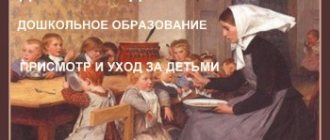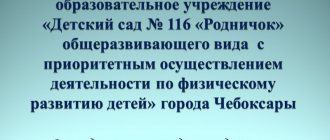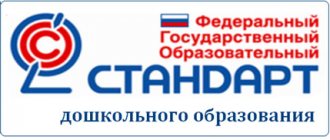The essence and types of educational programs for preschool educational institutions
The overwhelming number of preschool institutions are engaged in the general development of children, but even now, at the present stage, more and more institutions are appearing that pursue the following goals:
- early development of skills and abilities of preschool children (children's centers, kindergarten groups at lyceums and gymnasiums, etc.);
- combining in the process of raising healthy children with children who have problems in physical development;
- forming groups that function in conditions of learning two languages, and so on.
Are you an expert in this subject area? We invite you to become the author of the Directory Working Conditions
These changes in the work of preschool organizations occur in connection with the growing demands of parents who see the need to raise the level of development of children, to reveal certain abilities in children, as well as to prepare them for school. In addition, their cause is a change in the educational process itself in schools.
All existing preschool educational programs are divided into two large groups:
- comprehensive (general) programs that consist of the main areas in the development of children: speech, physical, cognitive, personal, social, aesthetic, artistic. They develop the child’s communicative, mental, creative, motor abilities, and also form specific types of activities - gaming, object-based, theatrical, musical, visual, etc.;
- partial (local) programs, consisting, as a rule, of one or several areas of child development.
Note 1
Integrity in the educational process can be achieved not only through the use of one comprehensive program, but also through the use of certain local programs.
Finished works on a similar topic
Coursework Modern educational programs for preschool educational institutions 430 ₽ Abstract Modern educational programs for preschool educational institutions 270 ₽ Test work Modern educational programs for preschool educational institutions 210 ₽
Receive completed work or specialist advice on your educational project Find out the cost
Additional education at preschool educational institutions
Kindergarten is a place where a child receives his first knowledge about the world around him, acquires and begins to show interest in various types of activities. Finding these interests is one of the main tasks of the preschool educational institution. But finding them is not enough; they need to be developed and supported. This problem is not new and can be solved by providing both paid additional educational services and free ones. These include a wide range of educational programs, characterized by their focus. The choice of direction directly depends on the child’s preferences.
Additional education is carried out outside the main educational time and cannot overlap with it. Their duration and quantity are determined in SanPiN 2.4.1.1249-03 and should not be higher than the maximum load on children at a given age.
Children's classes in sections and clubs have a positive effect on their communication abilities and contribute to their better socialization in society. It has been observed from experience that children who are engaged in additional education in addition to the main one, get used to school life much faster and show some success in it, and also continue to attend additional education sections outside the preschool educational institution, achieving new results and new victories. In the conditions of additional education, children can develop their creative potential, adaptation skills to modern society and get the opportunity to fully organize their free time.
The basic education of a preschooler and additional education should not exist without each other; education must be comprehensive, ensuring the full development of the preschooler in all the richness of his needs and interests.
Fortunately, at present, additional preschool education is in great demand, and therefore widespread. Preschool educational institutions offer a huge selection of options for extracurricular development of children. But everyone is united by the performance of some basic functions, such as:
- Educational function - thanks to the child’s presence in the company of other children, his communicative qualities develop more intensively, which also helps to raise the level of collectivism.
- Social function - due to constant communication with preschool children, the child acquires the ability to self-affirm.
- Educational function - depending on the chosen area, the child will be provided with certain knowledge on this topic, as well as additional skills and abilities necessary for future life in society.
- Developmental function - classes contribute to the development of mental, physical and creative abilities in children.
All of the above functions are present in every type of additional education and play a vital role in the formation of a child as an individual. The organization of additional educational services in preschool educational institutions is carried out in the form of circles, sections, and clubs. Their work is planned according to sections of the main educational program. In this way, students expand the knowledge and skills acquired in everyday activities.
Our preschool institution provides the following additional educational services:
- “ABVGDeyka” - develops a child’s literacy, immerses him in the world of letters and the alphabet, studies syllables and teaches reading
- “Multi-colored palms” is a program where children learn non-traditional drawing techniques, such as: finger painting, grottage, monotype, blotography, stamping, drawing with cotton swabs and others. Drawing with such techniques opens up plenty of scope for the child’s imagination.
- “Magic Cells” - the tasks of this circle are aimed at developing the child’s attention, concentration, thinking and imagination, the ability to navigate in space, and the ability to copy samples given by the teacher.
- “Calligraphy” is aimed at performing graphic exercises, forms spatial perception, mental operations, and fine muscles of the fingers.
- “Entertaining application” - develops children’s ability to work with their hands, use simple tools, develops creative thinking and imagination in children, and forms artistic and creative abilities.
- “Journey into the world of logic” - the main goal is to develop logical thinking, intelligence and ability to analyze, improve mathematical representation.
- “Plasticineography” - learning to work with plasticine, developing creative abilities and artistic taste.
- “Magic Sand” - working with sand helps children relax and relieve stress, develops fine motor skills and helps children share their emotions.
Our preschool educational institution pays special attention to creating the necessary conditions for the individual development of children. The most important factor is to ensure widespread availability and equal opportunities for additional education. Each child should have a certain set of skills and abilities after leaving a preschool educational institution. Additional education is also aimed at increasing the number of gifted children in various types of science and art.
But to achieve all the goals and objectives, additional education programs must be constantly refined and improved. It is necessary to work on creating new forms of work and improving the qualifications of teachers.
The value of additional education is that it strengthens the variable component of general education, promotes the practical application of knowledge and skills acquired in a preschool educational institution, and stimulates the cognitive motivation of students. Additional education for children allows us to provide conditions for the formation of leadership qualities, social competencies and the development of children’s creative abilities in various areas of educational activity. Every child is talented! All that’s left to do is help him believe in himself and find his way.
Being engaged in the provision of additional educational services, I understand that it is necessary to expand the range of additional services, create and expand the material and technical base for this, and improve the development environment.
Additional education occupies a strong position in preschool institutions. It implements a person-oriented approach to each child and allows us to solve many problems of his effective development.
Used Books:
1. Berezina V.F. Development of additional education for children in the Russian education system: Educational method. allowance. – M.: ANO “Dialogue of Cultures”, 2007. – 512 p.
2. Vasilyeva G.A. Innovations in the preschool education system: experience, problems, searches // Additional education and upbringing . – 2013. — №8.
3. Zolotareva A.V. Problems and prospects for including additional education in the process of implementing the Federal State Educational Standard for general education. // Vneshkolnik, 2011 No. 3//
4. Kazakova R.G., “Drawing with preschool children: Non-traditional drawing techniques: planning, lesson notes” / Ed. R.G. Kazakova.-Moscow: Sphere shopping center, 2005.-128p.
5. Solomennikova O. A. The joy of creativity. Additional education program. – M., 2006.
Characteristics of the main comprehensive programs of our time
Origins. This preschool education program is aimed at ensuring the holistic and comprehensive formation of the intellectual, physical and personal characteristics of children. It establishes the basic features of organizing a child’s activities in a preschool institution, the structure of the education and upbringing process, as well as the prerequisites for turning the program into reality.
Golden Key. Designed for children 3-10 years old, and is aimed at providing the most comfortable learning conditions for children in accordance with their age. Its peculiarity is the creation of conditions that will not only provide learning opportunities, but also preserve joy, emotions and happiness in the learning process for children.
Kindergarten is a house of joy . The first program whose main goal is the unique individuality of each student. Self-awareness and self-development are encouraged.
Paths. This program is designed for children 3-7 years old and aims to develop the child mentally through the use of creativity and imagination.
Teremok. Program for the youngest children - 2 months-3 years. The methods described in the program are innovative, variable, complex.
Steps to the school. The program is applicable to children aged 3-7 years. It comprehensively develops children, preserves and strengthens their health, forms functions that are significant for school, and reduces the risk of improper adaptation to school.
First steps. Designed for children 1-3 years old and aims to develop the child’s activity, emotionality, and independence.
Mosaic. Age group: children 2-7 years old. The program is designed to expand the potential of each child, open up opportunities for positive adaptation and socialization, ensure the development of the child’s personality, and show everyone their creative abilities. The newest ways of organizing educational work are proposed.
PRO children. The program encourages joint activities among preschoolers as they learn about the regulation of their own actions in the process and the actions carried out by their partners. The task of teachers is to develop children’s communication skills, logical thinking, and teach independence and responsibility.
Inspiration. The program sets clear goals and offers the tools teachers need to achieve this. It provides for building a high-quality preschool education process and creating an effective and modern environment for teaching preschoolers.
From birth to school. The new program was developed from the old one, created in 2004. It included new achievements in the practice and science of preschool Russian education.
Kindergarten 2100. The program should provide psychological and pedagogical support for the development of the personality of preschoolers and motivate children to reveal their abilities.
There are also many other complex programs that cannot be discussed within the scope of this work.




